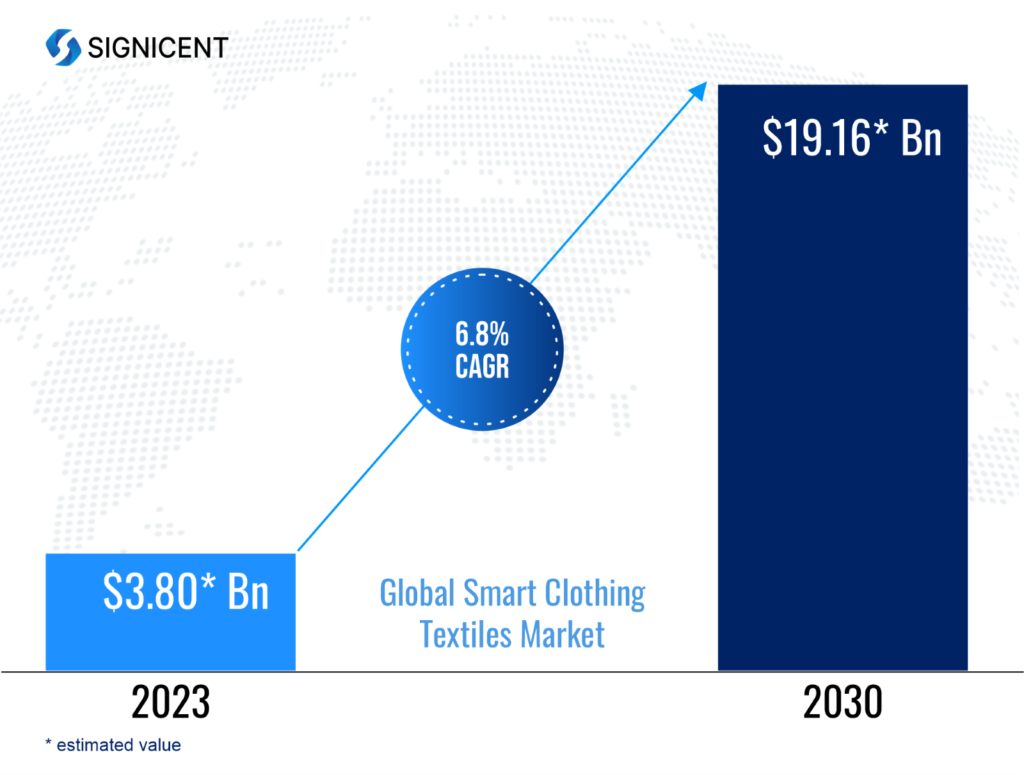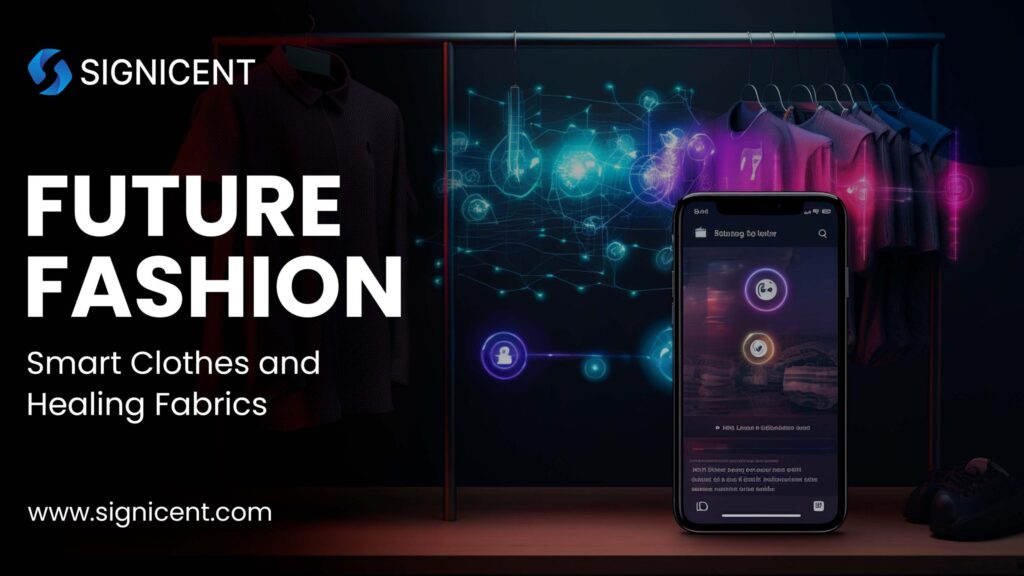Gone are the days when clothing was only about comfort or aesthetics. Today, smart clothing and self-healing materials are transforming the textile industry. These innovations merge technology, sustainability, and practicality, offering garments with advanced features such as health monitoring, bacteria resistance, and automatic repair.
But what exactly are smart textiles, and why are they gaining popularity? Let’s dive into the world of e-textiles and self-healing fabrics, a future where clothes not only make us look good but also protect, monitor, and adapt to our needs.
Signicent contributes to smart clothing and self-healing materials through technology landscape analysis, identifying innovations, market gaps, and emerging trends, enabling strategic development for clients in wearable technology.
What is Smart Clothing?
Smart clothing, also known as e-textiles or smart fabrics, integrates sensors, microcontrollers, and batteries into garments, allowing them to collect real-time data and interact with both the wearer and the environment.
These high-tech textiles serve multiple purposes, including tracking fitness metrics, monitoring health conditions, and even preventing injuries. From socks that sense foot pressure to T-shirts that measure heart rate, smart clothing blurs the line between wearable technology and fashion.
Challenges with Traditional Materials: Why Smart Textiles are the Future
Traditional fabrics, although comfortable, come with several limitations.
- Limited Durability: Regular fabrics degrade over time with repeated washing and use, leading to early wear and tear. This is a costly and unsustainable cycle.
- Lack of Specialized Functions: Conventional fabrics fail to offer protection against bacteria, UV rays, or environmental pollutants. Additionally, they don’t provide real-time monitoring, limiting their functionality.
- Odor and Stain Issues: Without specialized coatings, traditional clothes are prone to odor accumulation and stains, requiring frequent washing, which wastes water and energy.
- Incompatibility with Health Needs: Basic fabrics don’t meet the increasing consumer demand for fitness tracking and healthcare monitoring.
These limitations have driven the development of smart clothing and self-healing materials, which address both consumer needs and environmental concerns.
Signicent aids smart clothing and self-healing materials innovation through Patent Chemical Structure Search, uncovering novel compounds and materials, enabling companies to develop advanced, proprietary wearable technologies.
New Age Innovations in Smart Clothing
- Health Monitoring Capabilities: Smart garments are equipped with sensors that monitor heart rate, body temperature, and respiration in real time. This is particularly valuable for individuals recovering from strokes or living with Alzheimer’s. The technology alerts users and caregivers to abnormal readings, enabling faster medical intervention.
- Fitness and Performance Tracking: Activewear integrated with wearable sensors can track steps, calories, and muscle activity, helping users optimize workouts and reduce the risk of injuries. Unlike fitness bands, smart clothing offers more accurate data by being in direct contact with the body.
- UV-Blocking Technology: Some fabrics now incorporate UV-blocking properties, reducing the risk of sunburn and skin cancer. These materials either absorb or reflect UV rays, making them ideal for outdoor activities.
- Anti-Microbial Textiles: Smart clothing with advanced anti-microbial properties prevents bacterial growth and enhances hygiene. Technologies like zinc nanocomposites help inhibit bacteria, viruses, and fungi, protecting wearers from infections.
- Breathability ensures airflow for user comfort.
- Odor Inhibition prevents unpleasant smells, keeping clothes fresh for longer.
- Moisture Management wicks sweat away from the skin to avoid dampness.
- Non-Toxic and Durable: These fabrics are designed to be safe and retain their properties even after multiple washes.
Signicent drives smart clothing and self-healing materials advancement through Technology Gap Analysis, identifying unmet needs, innovation gaps, and opportunities to align R&D efforts with market demands.
Benefits of Smart Clothing and Self-Healing Materials
- Enhanced Durability: Smart clothing and self-healing materials offer extended longevity by repairing minor tears automatically. This promotes sustainability by reducing the need for frequent replacements.
- Improved Hygiene and Comfort: Anti-microbial textiles prevent contamination by resisting bacteria, ensuring clothing remains clean and odor-free for extended periods.
- Temperature Regulation: Phase-change materials (PCMs) like paraffin wax absorb, store, and release heat to help maintain optimal body temperature. Whether it’s hot or cold, these fabrics adapt to keep wearers comfortable.
- Eco-Friendly and Resource Efficient: The use of self-healing materials reduces textile waste by prolonging the garment’s lifespan. Stain-repellent and moisture-wicking technologies further minimize the need for frequent washing, saving water and energy.
- User Safety and Monitoring: Smart clothing provides real-time health monitoring, giving users the ability to detect early signs of illness or injury. This has made these garments increasingly popular in healthcare and fitness sectors.
Market Forecast and Key Players in the Smart Clothing Industry
The market for smart clothing is witnessing exponential growth, driven by increased demand for healthcare monitoring and fitness-enhancing wearables.
As per Signicent’s Market Researchers, the Global Smart Clothing Textiles Market is projected to grow at a (CAGR) of over 6.8% by 2030. The market is expected to reach values within the ranges detailed below.

Key Players in the Industry:

Market Trends:
- Healthcare Integration: Hospitals are using smart fabrics to prevent bedsores and track patient conditions in real time.
- Rising Fitness Awareness: The popularity of fitness wearables is driving consumer interest in smart activewear.
- Fashion Meets Functionality: High-end fashion brands are beginning to incorporate smart textiles, merging style with performance.
Signicent enhances smart clothing and self-healing materials development through Freedom to Operate (FTO) analysis, ensuring companies navigate intellectual property landscapes to mitigate infringement risks effectively.
Conclusion: Fabric Meets Innovation for a Smarter Tomorrow
The rise of smart clothing and self-healing materials signals a new chapter in the textile industry, where fashion meets functionality, sustainability, and technology. From health monitoring to odor resistance, these fabrics are revolutionizing how we interact with our clothing.
As technology continues to advance, we can expect even more innovations—like self-cleaning garments and AI-enabled textiles—that will shape the future of fashion. These materials aren’t just trends; they are transforming the way we think about clothing, bringing us closer to a smarter, more sustainable world.
FAQs on Smart Clothing and Self-Healing Materials
- What are smart clothes, and how do they work?
Smart clothes are fabrics embedded with sensors and digital components that monitor health and fitness metrics in real time. - How do anti-microbial textiles prevent infections?
Anti-microbial fabrics use technologies like zinc nanocomposites to inhibit the growth of bacteria and other microorganisms, preventing contamination. - What are the benefits of self-healing materials in fashion?
Self-healing materials repair minor damages on their own, extending the lifespan of garments and reducing waste. - Which industries are driving the growth of smart textiles?
Healthcare, fitness, and fashion are the primary sectors adopting smart textiles to enhance user experience and improve sustainability.
About Signicent LLP
We assist businesses globally in their technology innovations, R&D, new product development, patents, valuation, product commercialization & market research needs.
Services Offered:
- Patent Landscape
- Patent Portfolio Analysis
- Patent Invalidity Search
- Patent Licensing Services
- Freedom to operate (FTO)
- Chemical Structure Search
- Design Patent Search
- Technology Scouting
- Technology Landscape Analysis
- Technology gap analysis
- Technology Intelligence
- Market Research
- Bio Sequence Search
- Manufacturers Search/ Supplier search
Elevate your Innovation and Research with Signicent’s cutting edge approach to assist you with Technology and Market related matters alongside the IP aspect of the analysis.


